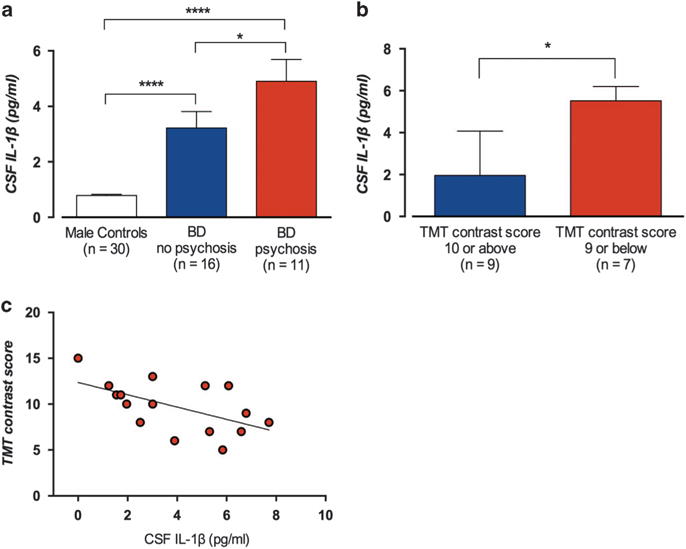Figure 1.

Cerebrospinal fluid (CSF) concentrations of interleukin-1β (IL-1β) in male euthymic bipolar disorder patients (data set I) and healthy controls. (a) Mean CSF IL-1β concentration (± s.e.m.) in 30 healthy male volunteers (0.79 ±0.044 pg ml−1), 16 bipolar disorder patients without a history of psychosis (3.06 ± 0.58 pg ml−1) and 11 bipolar patients with a history of psychosis 5.35 ± 0.71 pg ml−1. One-way analysis of variance (ANOVA) with Tukey’s post hoc tests, P<1 × 10−6; post hoc tests: controls vs nonpsychotic bipolar patients, P = 6 × 10−5; controls vs psychotic bipolar patients, P<1 × 10−6; and nonpsychotic bipolar vs psychotic bipolar patients, P = 0.020. (b) Of these patients, 16 carried out the trail making test (TMT). Nine patients scored ≥ 10 (mean standard score) and 7 scored <10. The median CSF IL-1β concentration was higher in the group with more difficulties in set-shifting (5.84 ± 2.89 pg ml−1 (median ± interquartile range)) compared with the group that scored ≥ 10 (1.96 ± 2.68 pg ml−1, Mann–Whitney U-test, P = 0.012). (c) A possible confounding effect of peripheral inflammation was assessed with correlation analyses. Increasing CSF IL-1β concentration was associated with difficulties in set-shifting (rs (Spearman) = − 0.53, P = 0.034), also when adjusting for high-sensitivity C-reactive protein (hsCRP) concentration (rs = − 0.59, P = 0.021). Error bars represent mean ± s.e.m. in (a) and in (b) median with third quartile. Two-sided P-values, statistical significance set to P<0.05. *P<0.05, ****P<0.0001.
